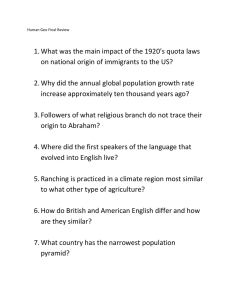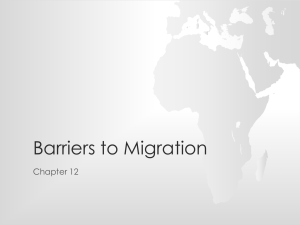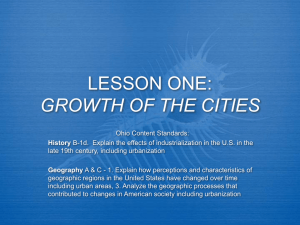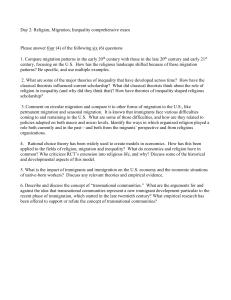Barriers To Migration ('page 2,)
advertisement
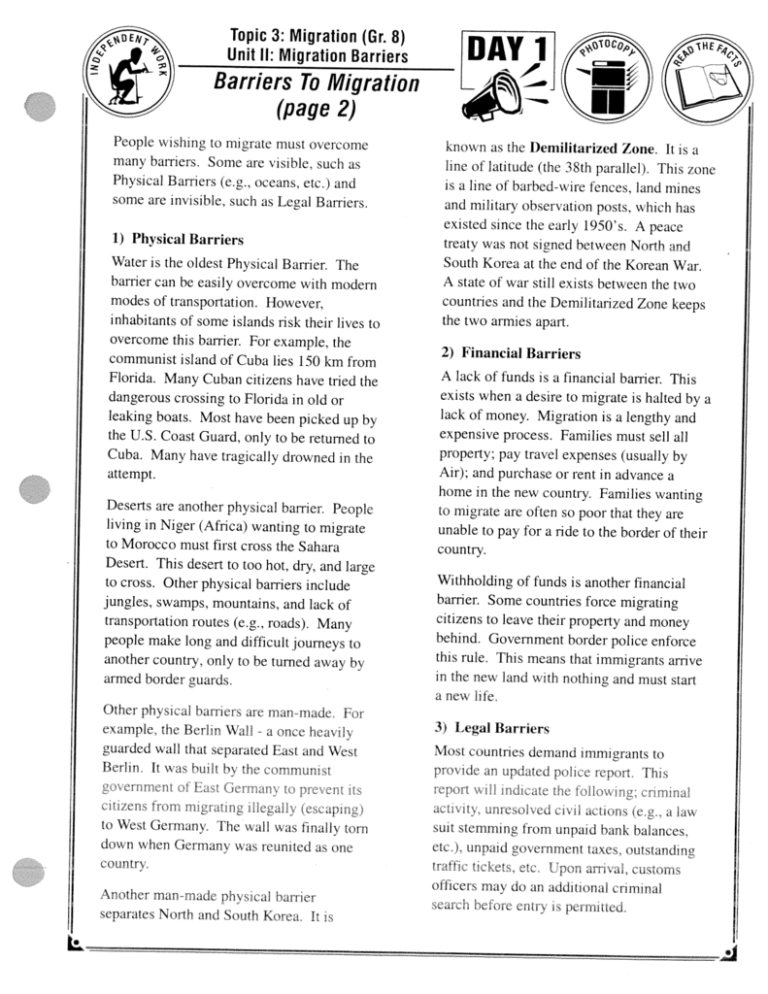
Topic 3: Migration (Cr. 8) Unit II: Migration Barriers Barriers To Migration (‘page 2,) People wishing to migrate must overcome mans’ barriers. Some are visible, such as Physical Barriers (e.g.. oceans, etc.) and some are invisible, such as Legal Barriers. 1) Physical Barriers Water is the oldest Physical Barrier. The barner can be easily overcome with modem modes of transportation. However. inhabitants of some islands risk their lives to overcome this barrier. For example, the communist island of Cuba lies 150 km from Florida. Many Cuban citizens have tried the dangerous crossing to Florida in old or leaking boats. Most have been picked up by the U.S. Coast Guard, only to be returned to Cuba. Many have tragically drowned in the attempt. Deserts are another physical barrier. People living in Niger (Africa) wanting to migrate to Morocco must first cross the Sahara Desert. This desert to too hot, dry, and large to cross. Other physical barriers include jungles, swamps, mountains, and lack of transportation routes (e.g.. roads). Many people make long and difficult journeys to another country, only to be turned away by armed border guards. Other physical harriers aie man made Fi example the Berin Wall a unee heavll\ guarded wall that separated East and West Berlin It v jc built h the omrnurnst i n mt 1 La t a iti,er fror mg aung i1kgal1\ iescaping) to West Germany. The wall vas finally torn don when Germany was reunited as one country known as the Demilitarized Zone. It is a line of latitude (the 38th parallel). This zone is a line of barbed-wire fences. land mines and military observation posts. which has existed since the early 1950’s. A peace treaty was not signed between North and South Korea at the end of the Korean War. A state of war still exists between the two countries and the Demilitarized Zone keeps the two armies apart. 2) Financial Barriers A lack of funds is a financial barrier. This exists when a desire to migrate is halted by a lack of money. Migration is a lengthy and expensive process. Families must sell all property: pay travel expenses (usually by Air); and purchase or rent in advance a home in the new country. Families wanting to migrate are often so poor that they are unable to pay for a ride to the border of their country. Withholding of funds is another financial barrier. Some countries force migrating citizens to leave their property and money behind. Government border police enforce this rule This means that immigrants arrive in the new land with nothing and must start a new life. 31 Legal Barriers Most countnes demand immigrants to pro\ de an updated pohe report. This ‘ L Another man made physical harrier separates North and South Korea. It is dCti it unresoi\cLl ci\ ii aefloas a iu\\ Suit stemming from unpaid bank balances, etc.). unpaid go\ernnlent tayes. outstanding traffi tickeL, CL. f pon arrixal. customs officers may do an additional criminal search I cfore eiitr is permitted Topic 3: Migration (Gr. 8) Unit II: Migration Barriers Barriers To Migration (page 3 4) Emotional Barriers Deciding to leave home forever is a very serious decision. It means leaving relatives. friends, pets, church and most possessions behind. The new country may be far away and the people speak a different language Elderly family members may refuse to emigrate. Young families may decide to leave the elderly behind. Often families stay behind to nurse the elderly. These factors must be overcome before a decision to immigrate is made. 5) Education Barriers Countries may impose a minimum education standard on all immigrants. Most countries demand that the parents of immigrants have at least a post secondary education. Education may also prevent certain citizens from leaving a country. People with specialized university degrees or certain highly educated professions such as doctors may be prevented from leaving. People with little education may soon discover that they are unable to migrate. Countries admitting immigrants want them to become successful. self-reliant citizens 6) Health Barriers Diseases such as tuberculosis malaria or lepros\ will halt entr\ into most cuuntnes In parts of the orld these diseases are common Third world countries UsUjll\ Ia k t e di n to it n .a e the r ci ins. \Yorkin, age immigrants v.iio appear frail and in poor health may he considered a health risk and denied access C )ufltfl s hke Canada with a rice Medicarc s stem rna vie these Immigrants as a healtF liahiht. arjd preveat theii entl\ 7) Political Barriers Some governments may label people as poli tical prisoners’. These citizens may have written an article that opposes the government. These countries usually prevent free speech and will imprison or ‘brand’ these outspoken people. Once branded as a political prisoner’ they will not he allowed to leave the country. Border Police prevent their exit. Those who are caught trying to leave by illegal means such as crossing a border at night are arrested and sent to jail. Dictatorships like Iraq, North Korea and Cuba prevent their citizens from emigrating. Citizens that travel abroad or represent the country in a sporting event are threatened if they do not return. Sometimes a person’s family is held hostage until the person returns. 8) Immigration Quotas The final barrier to migration is immigration quotas. Canada has an immigration quota that changes each year Countries may set these quotas as a reflection of the economy. For example during prosperous economic times the may raise the quota as high as ‘SO 000 new immigrants Poor economic tUnes mar seC this uuota drop to .00() ne’s’. immigrants. Topic 3: Migration (Gr. 8) Unit II: Migration Barriers • Barriers To Migration Study Organizer (page 4) DAY 1 PHOTOCOPY THIS PAGE II COMPLETE THE CHART I Category 3 Commurucation of Reqwred Knowledge ara I 1> Physical 2) Financial 3) Legal 4) Emotional 5) Education ———-——— 6) Health 7) Political 8) Quotas I. — :‘; L4LI: jyligration Barrier Description. explanation. example. etc. aa acme mc on 3 LI ‘ ca a E9 r a p’ aa area a apa a cnrca aim wa cr i e a a a a aa am a opy reaP ary a a al aj 1 a $ jab a b
